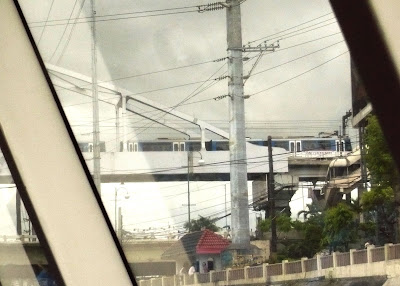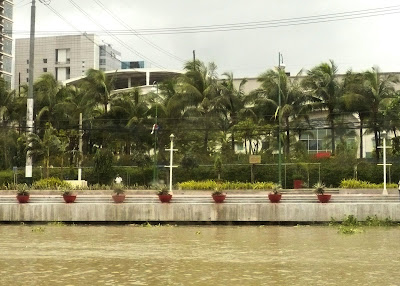
The sight of the Power Plant Mall signals that we have arrived in the City of Makati (former name: San Pedro de Makati, shortened to Makati on by Act 2390 of the Philippine Legislature in 1914). A coal-powered power plant used to stand on this very spot hence the name of the mall. It was incorporated into the Rizal Province in 1901 and was separated yet again in 1975 and became an independent city in 1995 (RA 7584). In July of 1937, Makati became the home of Manila's first airport, the Nielson Field, using 42 hectares of land leased from the Ayala family. Philippine Airlines' inaugural flight took off from Makati for Baguio in March of 1941. The former runways are now known to us as Paseo de Roxas and Ayala Avenue. The former airport tower, known as the Nielson Tower, is now the permanent home to the Filipinas Heritage Library. :-) More on this in a future post.
Without a doubt the trip can be described as leisurely and one can really sit back, relax, and take in all the view possible from your side of the ferry. To be honest, not all of the scenery is worth taking photos of. Anyway, you can always bring a book with you to read during the unexciting spots.
The ferry seats are wide and comfortable despite being made of tough plastic. The airconditioning doesn't make the interiors very cold, but otherwise the temperature inside is tolerable.
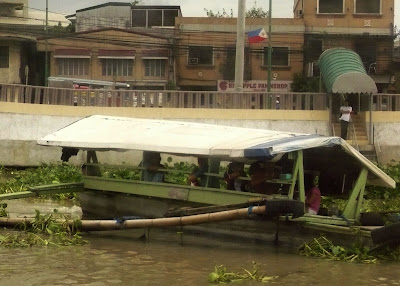
This looks dangerous, but this serves as the fastest way to cross the river for residents along the Pasig. It takes the place of the jeepney which takes the circuitous route. This one goes straight from point A to B with ease. It's the route Superman would have taken, you know.
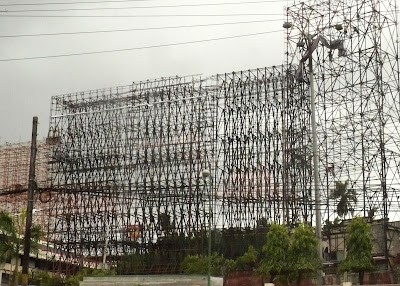
The controversial billboards of Guadalupe Viejo. They have been stripped bare because of the recent typhoon which hit the metro. TRIVIA: On Bernardino St. of Guadalupe stands the city's oldest and most historical landmark, the Sanctuario de Guadalupe, which was restored during the leadership of the revered Cardinal Jaime Sin.
A white-and-blue MRT coach crosses the rail bridge atop the Guadalupe bridge. Methinks the MRT system is a gift we all should be thankful for. I can't imagine traveling from North Manila to the South without this train system. Think hours of being stucked in traffic!
The Guadalupe bridge comes into view with the Guadalupe MRT Station above it.
The water may be generally brown but at least it isn't black - which is what it was several years ago before the revive-the-Pasig (Buhayin ang Pasig) movement. Already, signs of life have returned to Manila's most important river.
A play with words, this is what this is. "Pasiglahin" comes from the Tagalog word sigla which means vitality, ergo the tagline Ilog Pasiglahin means to restore the river's vitality. Not bad for a long-term plan (IF it is long term at all, but I'm crossing my fingers).
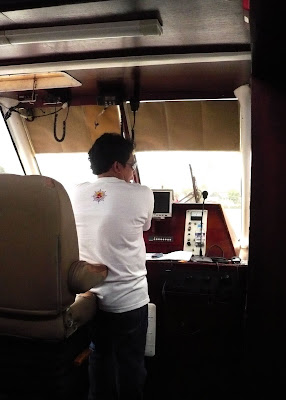
A quick peek into the bridge reveals very simple mechanisms for moving this ferry about. You can trust Filipino sailors in doing a great job in this business.
 I'm very excited about this tap card! Finally the technology has reached us in Manila. This is the system widely used in Singapore and Hong Kong.
I'm very excited about this tap card! Finally the technology has reached us in Manila. This is the system widely used in Singapore and Hong Kong. Our ferry leaves Guadalupe to proceed to the few last stations in Pasig City. Note the beautification done by the City of Makati on the waterfront. Soon there's be tap card or mCASH card for those who use the system frequently. It saves the trouble of having to line up and sign your name on the manifest every time you ride the ferry.
Our ferry leaves Guadalupe to proceed to the few last stations in Pasig City. Note the beautification done by the City of Makati on the waterfront. Soon there's be tap card or mCASH card for those who use the system frequently. It saves the trouble of having to line up and sign your name on the manifest every time you ride the ferry.This was our last stop - Guadalupe Station in Makati City. From here, people working in these parts can take connecting jeepney rides to their offices. It can be convenient on a clear day, but I can imagine it to be hellish on rainy days. Well, we have yet so much to work on.
 This is the waterfront of the Guadalupe Station. Looking forward to traveling the entire length up to Marikina soon! Mabuhay ang Pasig Ferry! Maligayang araw ng Maynila!
This is the waterfront of the Guadalupe Station. Looking forward to traveling the entire length up to Marikina soon! Mabuhay ang Pasig Ferry! Maligayang araw ng Maynila!


